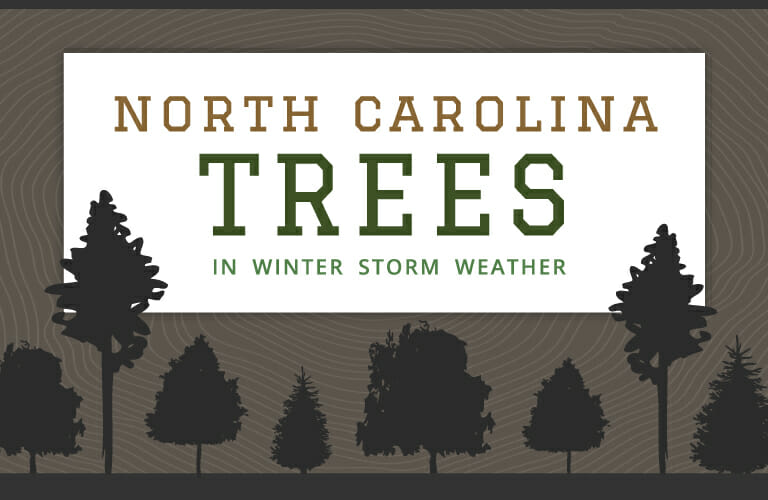Click Here to View Entire Graphic
Many people move to North Carolina to enjoy the mild winters. However, there are still plenty of winter storms. This can lead to broken trees and downed power lines. It doesn’t take a large amount of winter precipitation to add weight to tree limbs and power lines and this can quickly create hazardous conditions for your home.
Falling tree limbs can create problems for roads, power lines, and houses.
- Raleigh and the NC Triangle average 7 inches of snow a year.
- A 2014 snowstorm knocked out power for 50,000 people in Central North Carolina.
- Did you know that ice can increase the weight of a tree branch by up to 30 times?
- Just a 1/2 inch of ice accumulation can add 500 pounds of extra weight to a power line.
The trees that are most vulnerable to winter storms are weak-wooded trees with long branches that are unable to sustain the weight. Here are some of the trees you need to watch out for during North Carolina winters.
Bradford pear (Pyrus calleryana)
Average Height: 30-50 feet
Average Width: 20-30 feet
Bradford Pears are decorative trees found throughout the NC Triangle and they are known just as much for their springtime smell as they are for their beauty. Their rapid growth rate and weak limb structures makes them hazardous during winter storms.
- Prone to Breakage
- Pungent Smell
- Glossy, dark green leave with five-petaled white flowers
Leyland cypress (Cupressus x leylandii)
Average Height: 49 Feet
Average Width: 8-10 feet
The Leyland Cypress is a popular decorative tree throughout the South. They are popularly used as privacy trees because of their rapid growth rate.
- Weak Wooded
- Fast Growth
- Short, green needles and small, round cones
Loblolly pine (Pinus taeda)
Average Height: 90-110 feet
The pine tree is the state tree of North Carolina. The loblolly pine specifically is common throughout the Southeast. The loblolly has a rapid growth rate and can grow more than two feet per year!
- Power line Hazard
- Prone to Breakage
- Long, 5-7 inch needles with large cones
Water oak (Quercus nigra)
Average Height: 50-75 feet
There are 90 different species of oak trees in the U.S. The water oak is popular as a shade tree all over the Southeast. Its rapid growth rate and weaken its wood and make it vulnerable to storms.
- Susceptible to disease and pests
- Prone to breakage.
- Spatula-shaped leaves with ½ inch wide acorns
These are just some of the trees you need to watch out for during winter storms in the NC Triangle. If you think a tree on your property might pose a threat to your home or power lines, call the tree removal experts at Blackhawk Tree Services. Our team of professional arborists can trim or remove your trees to keep you safe during winter storms.

